- Home
- Users & Science
- Scientific Documentation
- ESRF Highlights
- ESRF Highlights 2016
- Facts and Figures
Facts and Figures
Members and associate countries
(as of JANUARY 2016)
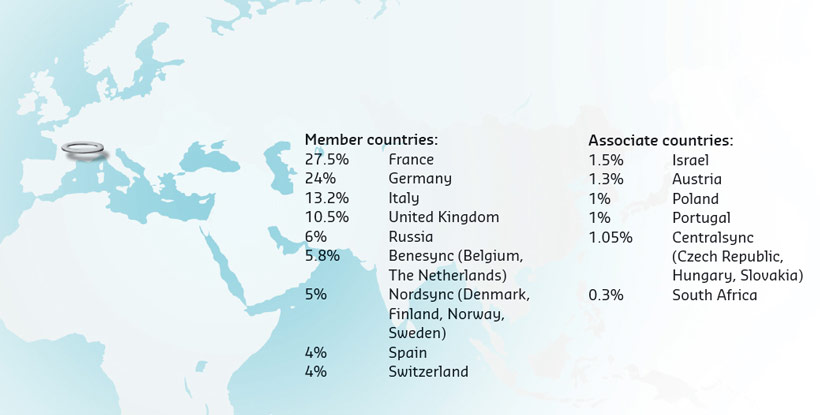 |
|
|
The beamlines
Details of the public ESRF beamlines as well as those operated by Collaborating Research Groups (CRG) are given in Tables 5 and 6. Figure 166 shows the location of the beamlines in the experimental halls.
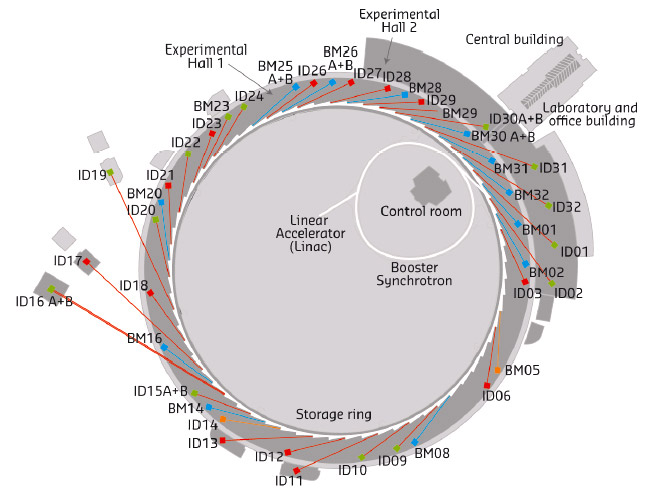 |
|
Fig. 166: Experimental hall showing location of the beamlines (public and CRG beamlines). |
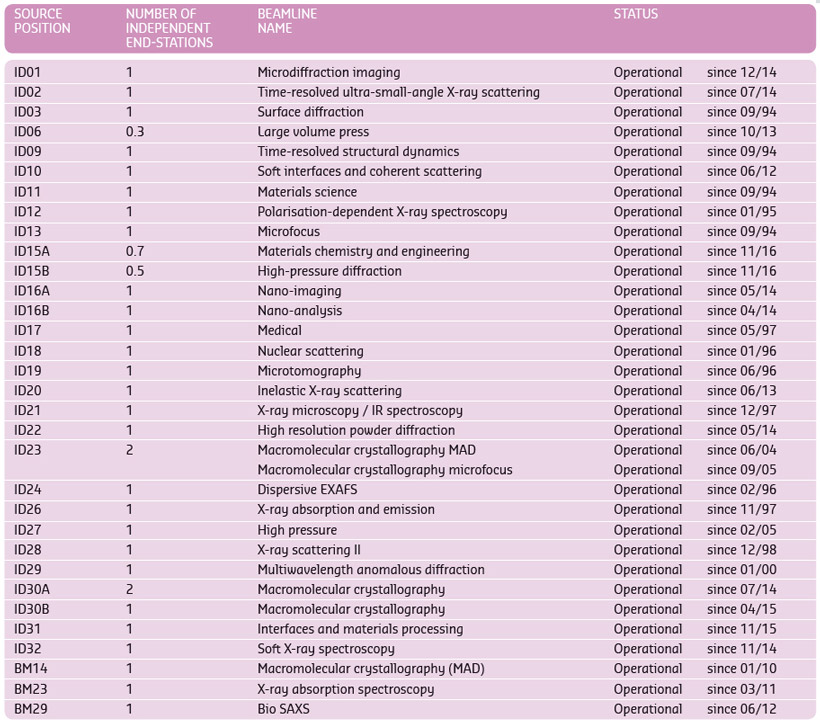 |
|
Table 5:List of the ESRF public beamlines. |
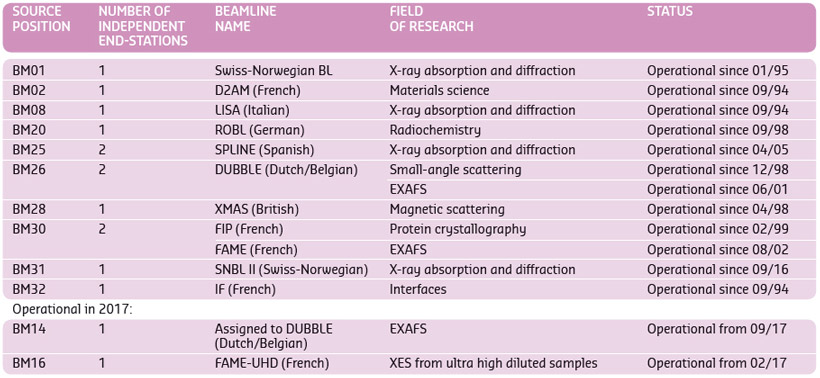 |
|
Table 6:List of the Collaborating Research Group beamlines. |
User Operation
User operation at the ESRF during 2016 has been at an all-time high, breaking several long-standing records in both interest from the user community and provision of beamtime by the ESRF to satisfy the needs of the growing community. In terms of the beamline portfolio, ID15, the final refurbished beamline, took its first users in early November, while BM14, the structural biology bending-magnet beamline, closed definitively at the end of October; this port and its infrastructure will now be used by the Dutch-Belgian consortium DUBBLE to operate a new CRG beamline to replace BM26A. The X-ray diffraction and XAFS SNBL CRG beamline BM01B was moved to its new port on BM31, opening to users in September. BM01 remains the SNBL single crystal and powder X-ray diffraction beamline (originally BM01A). The microfocus structural biology beamline, ID23-2, closed for an optics hutch upgrade in October and will reopen in May 2017, and finally BM16, the new CRG beamline FAME-UHD (French absorption spectroscopy beamline for material and environmental science - ultra-high dilution), was constructed and will take its first users early in 2017. Figure 167 shows the number of applications for beamtime received since ESRF Upgrade Phase I began in 2009. The number of requests for beamtime in 2016 has broken all records with a 15% increase demonstrating clearly the very strong interest from the user community to use the upgraded facilities now available.
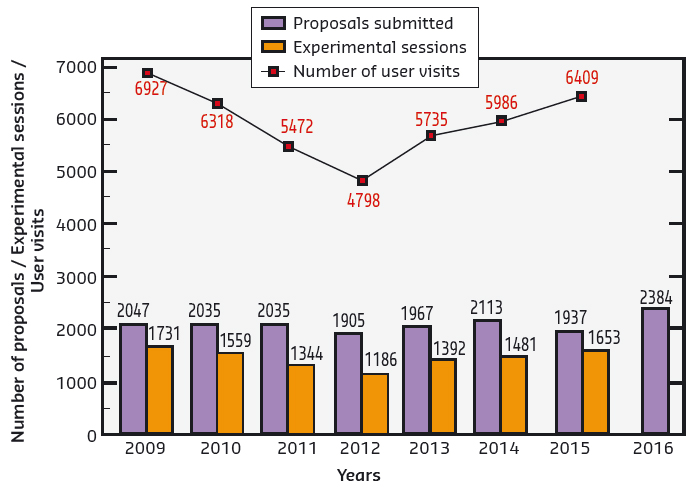 |
|
Fig. 167: Numbers of applications for beamtime, experimental sessions and user visits, 2009 to 2016. N.B. Final numbers of experimental sessions and user visits for 2016 were not available at the time of going to press. |
Proposals for experiments are selected and beamtime allocations are made through peer review. As in previous years, beamtime for 2016 was allocated based on recommendations made by review committees of specialists, for the most part from European countries, Israel and South Africa. These beamline-based committees review all proposals received for a particular beamline. This gives the committees an overview of all the projects proposed for a single beamline and allows them greater flexibility to optimise the selection of proposals that will be awarded beamtime on each beamline. Proposals for experiments in 2016 were reviewed by 11 review committees grouping the following beamlines of similar techniques or activities:
- C01 (ID01, ID03, BM25B, BM32)
- C02 (ID11, ID15A, ID22, ID31)
- C03 (ID12, ID32)
- C04 (BM08, BM16, BM20, BM23, BM25A, BM26A, BM30B, BM31)
- C05 (BM01, ID06-LVP, ID15B, ID18, ID27, ID28)
- C06 (ID17, ID19)
- C07 (ID16A, ID16B, ID21)
- C08 (ID02, ID13, BM26B)
- C09 (BM02, ID09, ID10, BM28)
- C10 (Structural biology beamlines)
- C11 (ID20, ID24, ID26)
The scientific areas of the ESRF research activities reviewed by these eleven committees are shown in Table 7.
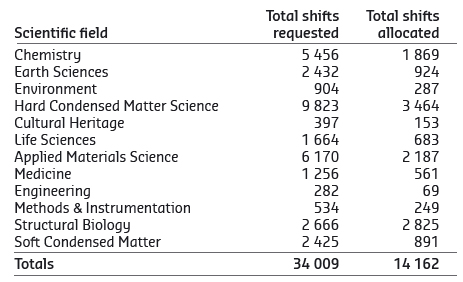 |
|
Table 7: Shifts of beamtime requested and allocated for user experiments, year 2015. |
Shifts of beamtime requested and allocated for user experiments, year 2016.
The review committees met twice during the year, around six weeks after the deadlines for submission of proposals (10 September 2015 and 1 March 2016). They reviewed 2384 applications for beamtime in 2016 and selected 962 (40.4%) in total, the second highest ESRF allocation ever. The change of the September deadline date from 1st to 10th September has given proposers more time after the summer and conference season to prepare their beamtime proposals, and successive records for proposal submission for the Autumn deadline have been broken in both 2015 (1135) and 2016 (1154).
Requests for beamtime in 2016, which is scheduled in shifts of 8 hours, totalled 34 009 shifts, smashing all previous records by 10%. Of these, 14 162 shifts (41.6%) were allocated. The distribution of shifts requested and allocated by scientific area for 2016 is shown in Table 7, while the number of shifts requested, allocated and delivered per year since 2009 is shown in Figure 168.
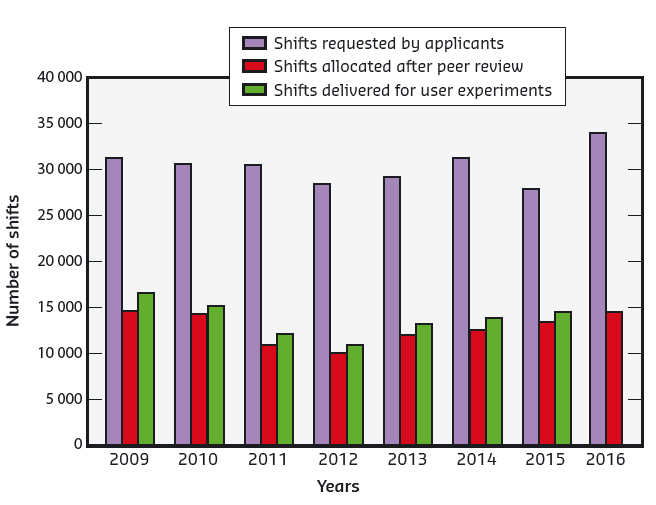 |
|
Fig. 168: Amount of beamtime requested, allocated and delivered, 2009 to 2016. N.B. The final number for beamtime delivered for 2016 was not available at the time of going to press. |
The breakdown of shifts delivered for experiments by scientific area in the first half of 2016 is shown in Figure 169. This same period saw 3484 visits by scientists to the ESRF under the user programme, to carry out 920 experiments; both figures are again records for the first 6-month operation period. Overall, the number of users in each experimental team averaged 3.8 persons and the average duration of an experimental session was just over 8 shifts (less than 3 shifts for MX experiments and 12.8 shifts for non-MX experiments). Faster and more efficient experiments are ensuring that more proposals can be accepted, maintaining an acceptance rate of over 40% despite the 15% increase in the number of proposals received. For this same reason, more experiments and users can be supported; the annual number of experimental sessions and user visits since 2009 is shown in Figure 167. Based on beamtime delivered so far in 2016, the number of experiment sessions for the full year is expected to be around 1850, with user visits expected to surpass 6900, while the total beamtime delivered for users is expected to top 16000 shifts for only the second time ever. These beamtime usage figures are again at record levels, indicating clearly the successful outcome of the first phase of the Upgrade Programme.
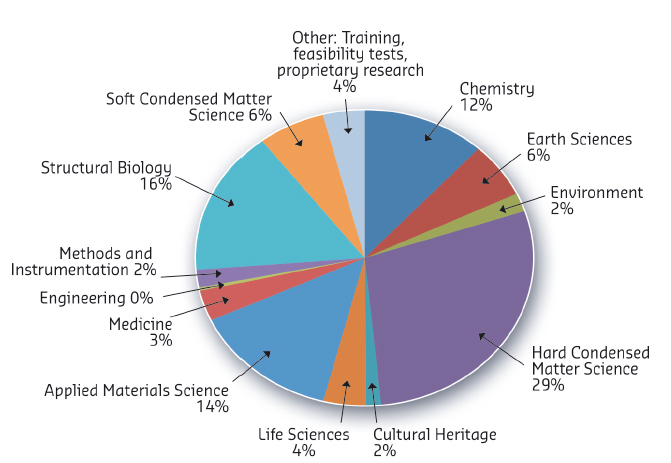 |
|
Fig. 169: Shifts delivered for experiments, March to July 2016, by scientific area, total 7895. |
One of the principle measurable output parameters of the ESRF is the number and quality of publications accepted in peer-reviewed journals. The number of publications rose continuously for many years, eventually reaching a plateau of over 1800 publications per year up until 2014, as shown in Figure 170. The publication figures in 2015 and 2016 show the expected drop in output resulting from the 5-month general shutdown of the ESRF back in 2011-2012 and the various beamline closures over the duration of Upgrade Phase I. This drop is however only very small, less than 100 publications per year, maintaining the ESRF output at a level well over 1700 publications for 2016 once all publications will have been accounted for. Since the ESRF began user operation back in 1994, a total of 28 671 publications have been accepted in peer-reviewed journals. Of these, around 300 every year are published in high impact factor journals and no drop has been observed here. These are excellent figures, showing that the ESRF research output is maintained at a worldwide high.
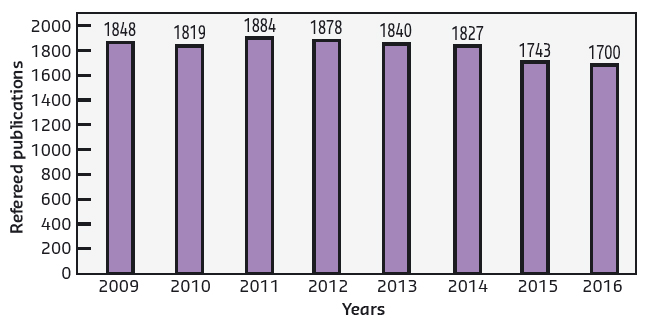 |
|
Fig. 170: Numbers of publications appearing in refereed journals reporting on data collected either partially or totally at the ESRF, 2009 to 2016. |
User responses to questionnaires show once again that the ESRF continues to maintain its excellent reputation concerning the assistance and service given by scientists and support staff at the beamlines, and travel and administrative arrangements, in addition to the quality both of the beam and of the experimental stations. On site offline facilities, such as preparation laboratories and collaborative platforms offering complementary techniques and support, provide a vital contribution to the quality of user support but also to the quality of the science and results that can be achieved. Major scientific advances can be made through the collection of complete and complementary data and information on the most important scientific questions. These aspects remain key to the continuing success story of the ESRF.
Administration and finance
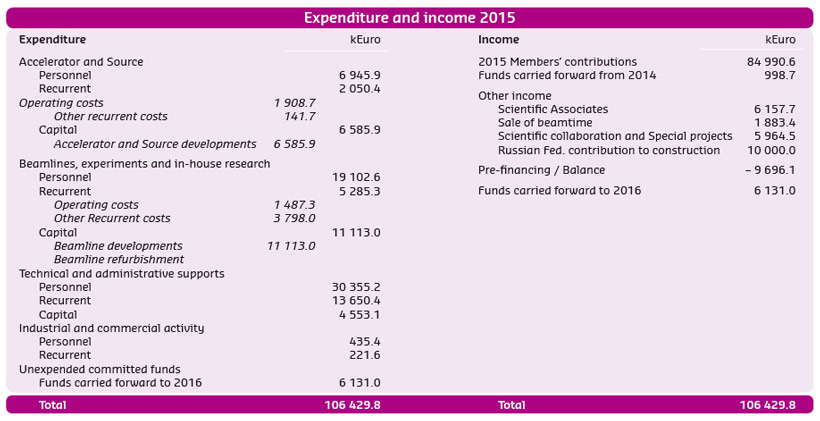 |
|
|
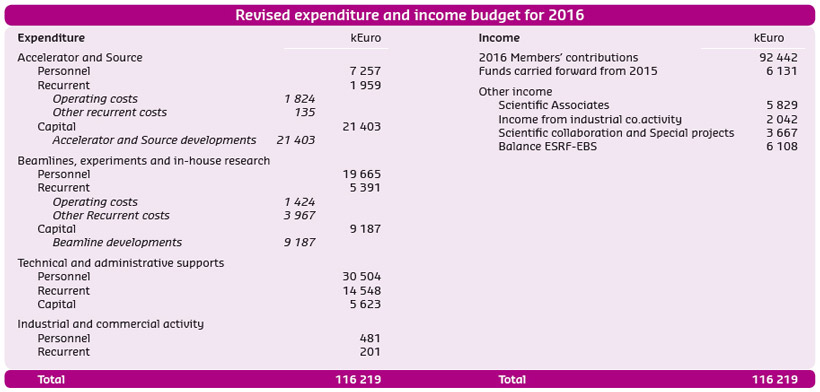 |
|
The budget for 2016 includes additional contributions from Members and Scientific Associates of 10 828 kEUR dedicated to the ESRF-EBS Project. The ESRF-EBS expenditure budget amounts to a total of 20 807 kEUR including 3 871 kEUR of ESRF operating budget. |
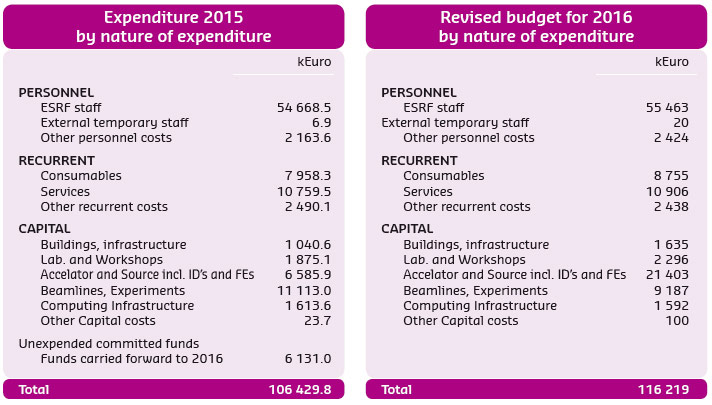 |
|
|
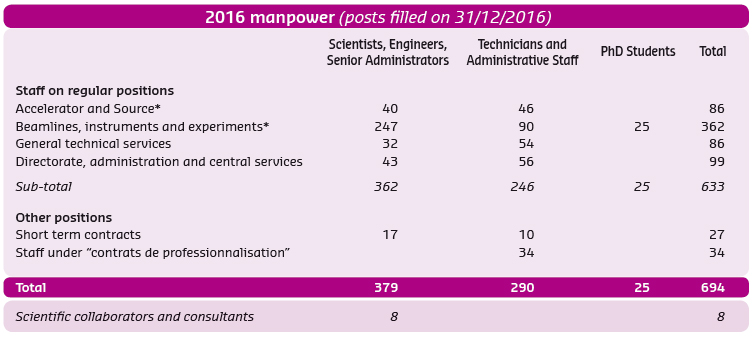 |
|
* Including scientific staff on time limited contracts. |
Organisation chart of the ESRF
(as of January 2017)
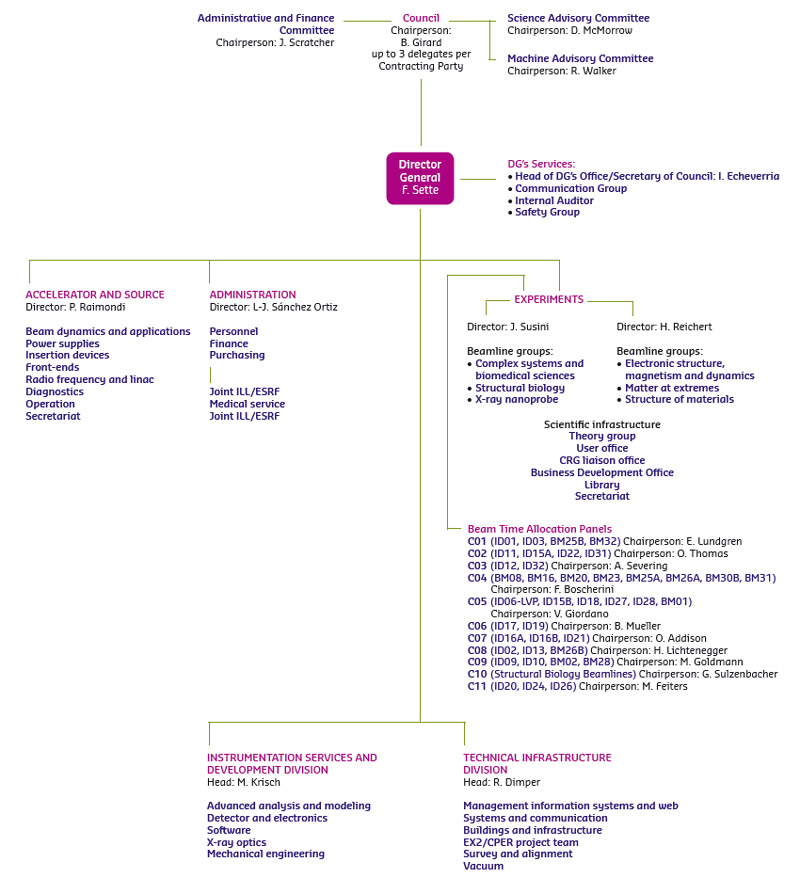 |
|
|



